As I mentioned in an earlier article, Virgin Galactic unveiled the design of SpaceShipTwo in New York on Tuesday. This is the first ever commercial tourist spaceship.
There are two ‘stages’ to this vehicle. A very large mothership, White Knight Two, and a not exactly tiny underslung SpaceShipTwo. The design is similar to that of SpaceShipOne and the White Knight One mothership but much larger. Notice Burt has gone to a dual hull ‘catamaran’ like structure so the space going craft is slung between them instead of underneath a center hull.
Another thing which jumps out at me is the use of four Pratt and Whitney PW308A turbofan engines. These are the sort of engines you would find on a large business jet and they need this sort of power to get SS2 up to the 50,000 foot MSL drop altitude.
White Knight Two test flights are expected to start this summer. If they are indeed going to meet that schedule, I would expect a roll out by late May.
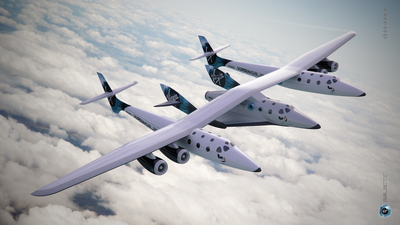
Artists rendering of SpaceShipTwo and the Mothership in flight
Photo: Courtesy of Virgin Galactic.
This is no paper spaceship. Both WK2 and SS2 are under construction. In the photo you can see both hulls and the main plane of WK2 are well advanced.

White Knight Two hulls and main plane on the Scaled Composites shop floor.
Photo: Courtesy of Virgin Galactic.
SpaceShipTwo is also well along, as you can see.
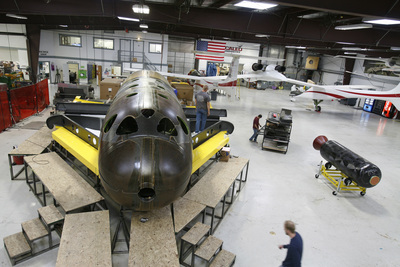
SpaceShipTwo under construction
Photo: Courtesy of Virgin Galactic.
SpaceShipTwo is not a tiny cramped little thing either as you can see in this photo with Burt Rutan providing scale. It is definitely more business jet than Mercury capsule.
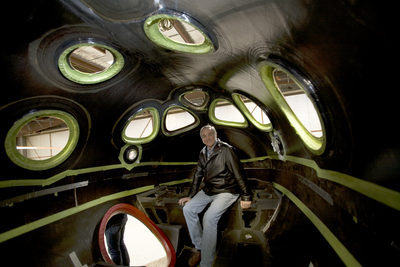
Burt Rutan sitting on the flight control panel in the nose of the SS2.
Photo: Courtesy of Virgin Galactic.
This is not a one off deal. There will be many of these produced and each will be flown as often as possible. That means they will need an ongoing training capability for pilots. So… they have a very nice looking flight simulator for training.
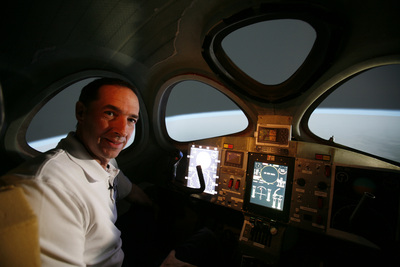
Test pilot Brian Binnie sitting in the SS2 simulator.
Photo: Courtesy of Virgin Galactic.
For the technically inclined, here is a cutaway drawing. The real cognoscenti will note SS2 is indeed using the original hybrid propulsion system. Hybrids have been around awhile now: Starstruck and AMROC (Jim Bennett’s old companies) pioneered them in the eighties and others have since developed them further.
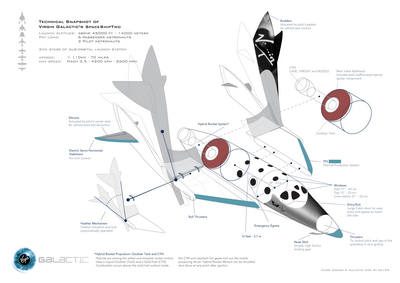
Cutaway technical details of SS2.
Photo: Courtesy of Virgin Galactic.




And yes, I am well aware that hybrids were first worked on in the fifties, probably with Aerojet since they did all the cool stuff back then. But hybrids never went anywhere until Starstruck and AMROC.
Sir Richard Branson and Burt Rutan pairing up–it is good to see that a little daring yet lives in the world.
The last sixty years were only a temporary hiatus in the great age of exploration.
Who will get to the asteroids first? Government? or private enterprise?
Anyone want to bet a fiver on this?
Talking about resources, in his 1979 book, ‘A step Further Out’, Jerry Pournelle provided an estimate that there were 30,000 metallic asteroids, each one of which contained, at a minimum, material equivalent to being able to maintain the entire world population at a level of consumption equivalent to that of the United States for a single year. Some, many orders of magnitude more.
Now getting it down to the Earths surface would be expensive, but getting it into orbit, or into a leGrange point, much less so.
Guys, once we get up there, it is, to quote Niven/Pournelle, raining soup, and NASA is still just researching whether we should put resources into developing bowl technology.
wankers
Talking about resources in Dales previous posting, I gotta say –
The moon will be useful as a way station, and Mars is an irrelevancy.
The real centres of population and industrial might will be the Trojan and Geek asteroids, Jupiter orbit and Saturn orbit. Maybe Ceres, but I doubt it.
Anywhere there is vast quantities of free floating material outside a gravity well, and constrained into a small volume, will be where the action is.
I agree about the asteroids. I’m not as bullish about Mercury in the short to medium term- it may well be loaded with metals, but getting it back to Earth out of the sun’s gravity well is going to take a lot of juice. Although solar sails might help there.
I just hope to live to see it all unfold.
My God, that thing’s beautiful.
Look at the pic of the SS2 nose-on. Pure, unadulterated Norman Bel Geddes. Space is going to be fun!
As they say on Ace’s blog…
I’ll be in my bunk!
It is gorgeous, isn’t it?
What we need is a Conestoga. Cheap enough for a family to buy and stock, and capable of taking them to the new lands.
It finally looks like we, as a species, are going to spread the oh so wonderful virus of our civilization beyond this rapidly disintegrating rock and into the beyond.
Counting Cats: With the odds so heavily stacked in favour of private enterprise and gov’t so averse to spending money on projects whose benefits are long term and long term only. I don’t think there will be any contest.
And since you mention Dr. Pournelle… he is an XCOR investor and his son Rich works there as well. Lots of good things happening at XCOR too. Not to mention they are among our readers 🙂
Mandrill,
And with NASA stuck in “back to the future mode”. and with the truly bizarre idea of naming their new old rockets Ares after the ancient Greek god of massacre…
Did you know navigational data is stuck on the shuttle computers with 51/4″ floppies. NASA get them on EBay apparently. Oh and the khazi on the shuttle cost 30 million bucks. It reminds me of the old cosmonaut joke. Nasa spent billions to develop a pen that works in space. The Russians just took pencils…
Are there any other aviation folk here who notice how far out on the moment arm those turbofans are and wondered about adverse yaw if one fails on takeoff?
I presume that having two on each side gives some latitude so long as there are no common mode failures. I’d hate to be the one trying to deal with a takeoff with two engines out on the same side. T’would be time for the pilot to judiciously apply several rolls of tissue…
Thoughts occurring to me:
1. Assuming the wheels are attached to the two fuselages of the mothership, that thing looks too wide for conventional runways. Will it have its own special base?
2. The mothership appears to have cockpits in both fuselages. Will the pilot be in one and the copilot in the other, or will one just be kept as a spare?
Sorry you missed the party Dale. It was fun. there were two distinct crowds, the Bransonistes who tended to be Brits or Euros and the US space crowd including some of our favorite people.
George Whitesides gave Patti Grace Smith a special tribute. She’s earned it for her efforts to keep the overegulators off the backs of the new space industry. She will be missed.
BTW Nick The pen story is an urban legend.
Anyone know why Mr. Rutan has abandoned canards? I have read that Global Flier which had none was more stable than Voyager which did, so that might be the reason.
This thing is a joke. The legal definition of outer space being at sixty miles is absurd–if you aren’t in freefall orbit, you aren’t in outer space.
Getting sixty miles up is not just useless, it’s downright easy. Rutan’s statements that he’s done what NASA can’t is absurd–besides Rutan using all the research NASA did in the 50s, 60s and 70s, NASA knows that the challenges of going 60 miles up have very little to do with obtaining orbit.
Finally, I’ll bet the costs for this thing end up being magnitudes greater than predicted and that it crashes within half-dozen flights.
(I’m not a luddite–far from it; I used to be a huge fan of manned space travel. Now, I think it’s a poor use of resources. We get far more bang for the buck and far more hard science using robots [the “we needed manned travel to repair Hubble” argument is bogus since Hubble was designed to provide an excuse for the space shuttle in the first place. It could have, and should have, been designed to be repaired by robots.])
Joe,
People don’t go into space for science. They go to expand the human experience. Robots just send postcards or pictures home. Presumably you actually now and again travel somewhere else to experience a new place or do something that you cannot do at home instead of looking at videos of that new place?
People will travel into space for the experience and hopefully in the future will live and work there and love and laugh and cry for there will be tragedies as well as great triumphs as we have already seen. Just as on Earth.
We really don’t have a choice as a species. A future without human spaceflight is too awful to contemplate.
With human spaceflight anything is possible and as Ray Bradbury once wrote “to a universe that cannot see, we bring the gift of eyes”.
Dale,
Yes, the way far apart engine positioning, but also the single connecting member.
I cannot imagine a cross member rigid enough to totally eliminate all torsion flex. The possibility of oscillations developing to the point of failure seems rather likely. Especially due to the length (and therefore torque) of each fuselage on the connecting member. Do they plan some kind of active damping system?
I’m not an engineer. Is this a non-concern?
I think Joe misses the point. Most of us support the science only insofar as it advances our goals of getting ourselves in space. If suddenly space were about nothing but robots… I’d vote to just cancel NASA entirely. It would no longer be producing *ANYTHING* I cared about.
But then that is a moot point. We don’t need NASA anymore anyway.
How does Rutan/Branson expect to make any money out of this thing ? The only revenue source I had heard of was wealthy tourists, but I can’t believe there are enough of those to support a fleet of these craft. Has Branson found another hidden government subsidy of some sort ?
Also, isn’t Joe right that these things are nowhere near strong enough to put anything into orbit ? If all they can do is go up and come straight down, then aren’t they rather a dead-end technology ? How will they lead onto something useful ?
I would suggest you do some research. They are sold out for several years at this point.
I’ve posted at length in the past about how to build from up and down tourist flights into point to point and eventually global transport. Think a little. How did those silly Wright Brothers contraptions go from joy rides for the wealthy to being a regular form of transport? Preposterous! If man were meant to fly, God would have given him airplanes. Hmmm… He did. I guess we were meant to fly then.
These things are not Billion Dollar White Elephants like the government flies and the sooner you get the point that the government has given everyone a false impression of the economics, the better.
Oh, and there is supposedly a second pair under construction already, or so I have read.
Oh, and yes. This generation of craft is NOT orbital. First ones to do orbital will probably be SpaceX or perhaps BlueOrigin or perhaps another company that is also at Mojave. You will have to wait a couple years.
File this under “Crawl before walking before running”
I suspect that the real money will come from suborbital continent to continent transport. The travel time will make the Concorde look like a Cessna.
Dale – OK, time to hit the search button. For the avoidance of doubt, I grew up on Heinlein, and I also want to go to the moon. I’m just kinda grumpy about how long it’s taking.
Interesting discussion of spaceflight aspects of cheap fusion power at
NASA Spaceflight
And a slide show by Tom Ligon at ISDC May 007
A hundred years ago, as a curiosity, one could buy a ticket to go for a circuit in an aeroplane above a field in Ohio, or the North of France. It was a sort of Bunjee jumping but with a serious chance of death.
What Space Ship Two brings is the same new thrill.
The effect on space flight will be the same as these “circuits and bumps” did for the devlopment of aviation: provide owners with some revenue, create a pool of pilots, get the public used to the idea.
Antoine, your comments are part of a common meme circulating about SS2 and sub-orbital hops but I’m afraid the analogy doesn’t really hold up to much scrutiny.
The costs, even adjusted for a century of inflation were much much less than we’re looking at for SS2 flights or any of the other proposed sub-orbital entrants. It won’t really train a pilot pool as the skills for the flying are pretty much existing jet skills.
The risks are harder to quantify. The chances of having an accident on a barnstorming flight were never really high. Higher than modern aviation, but unless there was a problem on take off and the plane stalled badly and dropped out of the sky, the aircraft flew pretty slow and low so the danger was always more imagined than real. That’s not to say people didn’t die, but I’d be surprised if it was many people seeing the roof of a barn or a field.
SS2 should be pretty safe, but given the velocities involved some of the failure modes are much worse than a biplane.